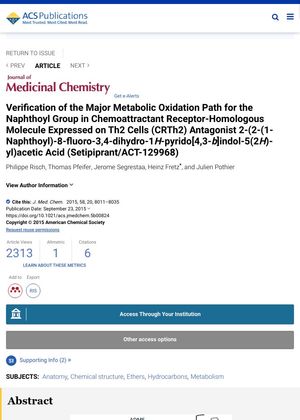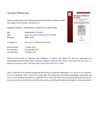Verification of the Major Metabolic Oxidation Path for the Naphthoyl Group in Chemoattractant Receptor-Homologous Molecule Expressed on Th2 Cells (CRTh2) Antagonist 2-(2-(1-Naphthoyl)-8-fluoro-3,4-dihydro-1H-pyrido[4,3-b]indol-5(2H)-yl)acetic Acid (Setipiprant/ACT-129968)
September 2015
in “
Journal of Medicinal Chemistry
”

TLDR The document confirms the structures of major metabolites of the CRTh2 antagonist Setipiprant and identifies minor metabolites.
The document from 2015 investigated the metabolic oxidation of the CRTh2 antagonist 2-(2-(1-naphthoyl)-8-fluoro-3,4-dihydro-1H-pyrido[4,3-b]indol-5(2H)-yl)acetic acid (Setipiprant/ACT-129968). Various analogues of this compound were synthesized to understand the regio- and enantioselectivity of its metabolic oxidation and to confirm the structures of four metabolites proposed in a previous clinical ADME study. The two major metabolites, M7 and M9, were confirmed as specific dihydroxy-dihydronaphthalene-carbonyl compounds, each composed of two enantiomers with 68% and 44% enantiomeric excess in favor of (+)-(3S,4S)-M7 and (+)-(5S,6S)-M9, respectively. The minor metabolites M3 and M13 were identified as specific hydroxy-naphthoyl compounds.




